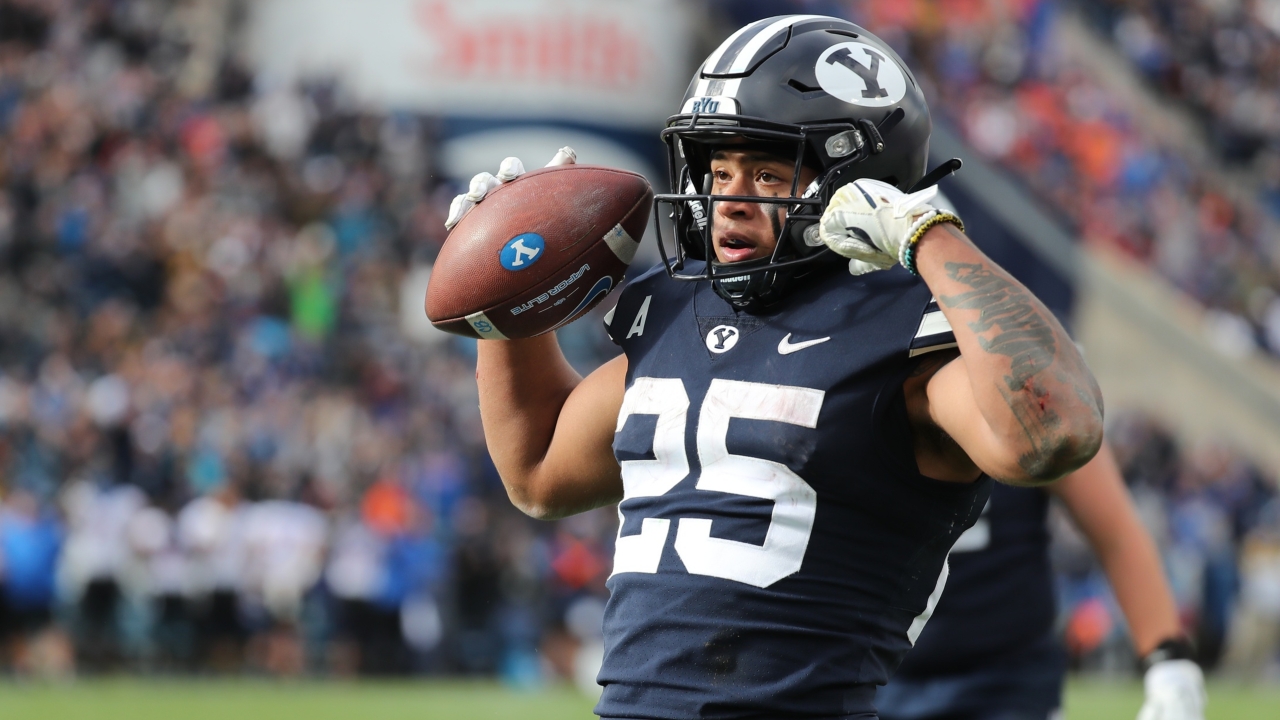
First Look At BYU's Advanced Depth Chart
This is part one of my Baylor vs BYU preview covering their roster, athleticism, and experience. Later parts will X’s and O’s and stats.
The Most Veteran Team I Have Seen Baylor Play Against
BYU is a program that has a proud tradition, a 5-1 record, a #20 ranking and a depth chart where its players listed average being five years out from High School. It’s a unique program that has done a good job developing players into a physical and versatile roster.
BYU's history as a brand is with Ty Detmer, Jim McMahon, Steve Young, Robbie Bosco and others throwing the ball out of the then-wide open West Coast offense and throwing for tons of yards. That was perfect for that time but the overall roster strategy wisely has changed to suit the strengths of who it can reliably recruit.
However, BYU’s path to winning now has resembled Iowa, Wisconsin, ISU, KSU and Stanford. BYU develops and do so in the trenches. BYU can throw it and can make big plays but where it wins is by having mature lines, Tight Ends, Linebackers, and big tailbacks that can pound away at defenses. This was even true when Bronco Mendenhall's teams ran variations of the Air Raid. BYU simply put can produce more and better NFL caliber guys at TE, DL, OL and LB than it does at Wideout, DB, or RB. Basically, this is the roster opposite of Texas Tech.
Below we look at the BYU players, how big they are for their position, their high school 40 times, shuttle times, vertical jump, games started, games played, and years removed from high school.
Each number will be a shade of green, yellow, or red based on how that number ranks relative to expectations for the position based on my views for the position that originate with Mockdraftable.com’s position aggregates before I adjusted for college and Big 12 play. Green is good, yellow is average, and red is poor.
For games, starts, and year it will be based on starting two full seasons, playing in three seasons worth of games, and how many years out of five a typical player could usually potentially play.
Note: Games and starts were taken from the prior week’s game notes against Boise
Offense
This offense was recruited to run the Jeff Grimes wide zone scheme and has filled the roster with great system fits. The primary QB’s are capable passers and dangerous runners, the backs are downhill guys with speed, the wideouts are athletic guys with size, and the line is tall & mobile with several years in the weight room behind them in most cases. It’s a very experienced unit where only the starting QB, part time starting RG, RT, and one part-time starter at WR have less than 10 starts in the primary group of guys. Even then only one guy in this group has fewer than 12 games of experience overall.
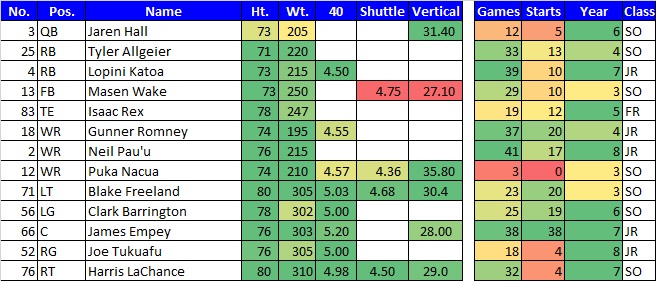
BYU’s main guy at QB is Jaren Hall who is dangerously athletic. He could be a RB or WR if he had to and has a strong arm. He has completed 59% of his passes with 8 TD’s and 3 INT’s but also has run for 163 yards on the season even with sacks holding him back for over 7 yards per carry.
His backup is Baylor Romney. Romney has solid speed but isn’t as physical of a runner. He has a good arm but is more likely to hit high efficiency throws underneath from what I have seen. Conover is the third stringer who was a four star recruit and the fanbase is excited about long-term.
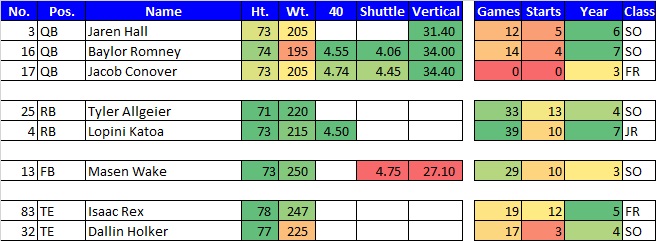
The main tailback is Tyler Allgeier who was a freakishly athletic walk-on who developed into one of the best backs in the country. He’s a near-perfect fit in this system and is a physical runner with a high motor. He ran for 1,130 yards last fall and has over 600 this fall. His backup is Oregon State transfer Lopini Katoa who has 165 yards on the season after 444 last fall.
Isaac Rex is BYU’s best guy at Tight End and is coming off a 2020 season with 429 yards and 12 touchdowns. The unique guy who makes things go for them as a blocker and as a surprisingly good receiver with a habit for hurdling defenders is Masen Wake.

Wideouts feature some solid talent and remind me a bit of the groups we saw at ISU and to a lesser extent WVU. Gunner Romney is BYU’s best guy currently and has over 1,000 yards since the start of 2020 and finished last season with over 19 yards per reception.
Pau’u is a good possession guy with the most receptons this fall and 12.7 yards per reception but can make the big play too with a long of 67 yards this year. The Nacua brothers transferred from Washington and Utah and are athletic options outside. The guy with probably the best track speed is Jackson.
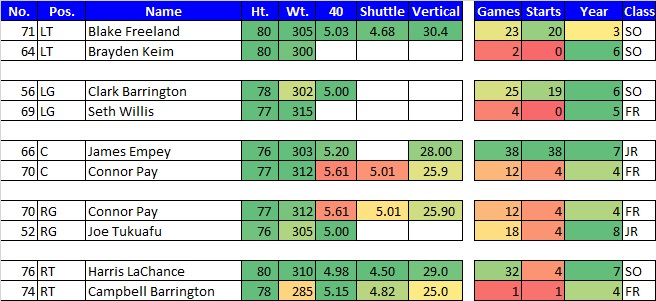
This line has a lot of solid athletes and it’s a testament to Jeff Grimes and Eric Mateos finding guys that fit what they want to do that they can grow into their frames to develop into a high caliber line. It obviously doesn’t hurt that due to two-year missions and the whole COVID “everyone gets an extra year” thing you have basically all of this group operating on year four or later of weight room work. That said they move well with the shortest tackle at 6-6, they aren’t lightweight, and they have depth. Solid unit.
Defense
BYU's defense was easily the most work I have had to put into one of these. Most teams have 11 or maybe 12 positions on the depth chart. BYU? SIXTEEN.
So to break this down I’ll look at the ones that are typical D-Line, typical Linebackers, typical secondary, and then several that blur the line between groups. BYU’s defensive scheme originates from a 4-3 under coaching tree but it does a lot more 3-4, 3-3-5, or 3-2-6 these days. BYU mostly transitioned to a three-down defense though it will mix it up as BYU is very multiple in what they do.

BYU’s defensive line features five positions but I consider the T, DE, and SE spots pretty interchangeable based on what I see on film. It’s a group with solid size, tons of veterans with offseasons in the weight room, and probably not the same edge quickness we saw from OSU or WVU. The SE spot is probably a hybrid position but I included it here as it seems to make more sense.
Open End is what most 4-3 teams have as a lighter & quicker weakside pass rushing end. The Nose has two very physical options in Mahe & Haws. Tuoti-Mariner stood out in the film I saw at Tackle.

BYU’s primary three “pure" linebacker spots as we’ve seen in the Kyle Whittingham 4-3 under that Sitake was brought up under. The Flash is their Strongside backer and their best Linebacker Payton Wilgar roams here. His backup is Jackson Kaufusi who may be the 1,000th Kaufusi I have heard about playing at BYU. They’ve had a lot of that family there.
Ben Bywater is the replacement in the middle for their prior starter Pili who is injured and is one of the youngest contributors we see on this defense.
BYU’s ROVER is a glorified WLB spot which is basically what Eddie Lackey or Terrel Bernard played at Baylor. It's the spot usually given more protection from blockers and more coverage on backs. Smaller & quicker guys thrive here and Tooley seems like a great fit.
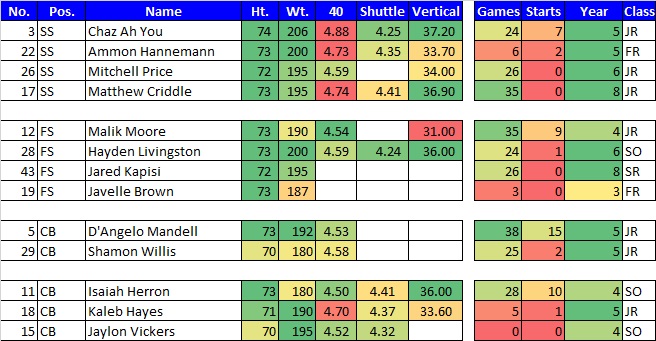
BYU’s biggest playmaker in the safety spots is Chaz Ah You who is the Strong Safety. He’s usually to the boundary. In BYU’s sub packages he’ll slide down to play as a de-facto Linebacker a lot of the time. Moore is the field side safety and gives solid range.
BYU has massively upgraded their single coverage capability at corner since the Mendenhall days. Mandell is probably their best while Herron and Hayes rotated as starters opposite him.
However, BYU make a large usage of hybrid players. Below are what they have at each.
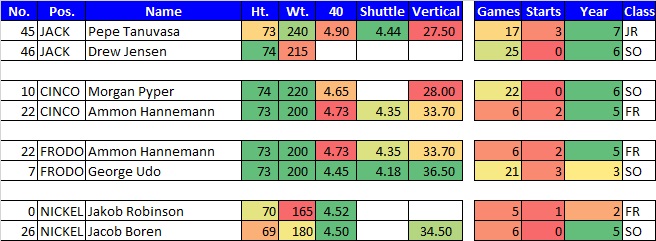
JACK is pretty common in college football. It’s half Defensive End and half Linebacker. Basically this spot is usually a boundary side edge player in their defense just as likely to rush as drop into coverage. Tanuvasa has done well here.
CINCO is basically an extra safety. Pyper sees a lot of time at this spot and Udo gives a speedier option here as well.
FRODO is similar but seems a bit heavier. However it's hard to tell which is which since #22 lines up at both. If I had to guess it's more of a box safety.
Nickel is the easiest to understand. It's an extra corner and usually in the slot. Smallest of the hybrids and most coverage oriented. Almost always will see Robinson here.
Based on who has started this is the group we usually see from BYU in some combination.
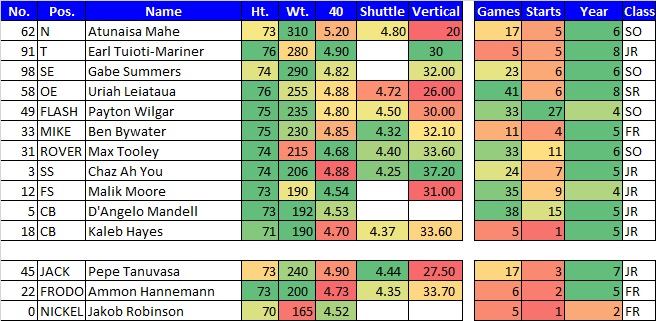
It's a group with a lot of games and a lot of years of development under their belt. However they lost several experienced starters after 2020 and several positions are pretty typical speed wise. This group is solid but the offense is more built up from a roster perspective due to how hard graduation hit each.
Conclusion
This team is physical, mature, and fits their systems well. Baylor probably has the team speed advantage but don't expect anything less than a knock down drag out fight. They will come into Waco looking to put last week's upset loss to Boise where turnovers and missing a fourth down in their own territory basically handed the game to the Broncos behind them. Bears need to be ready for a very strong roster lining up across from them.
Follow @Baylor_S11 on Twitter!